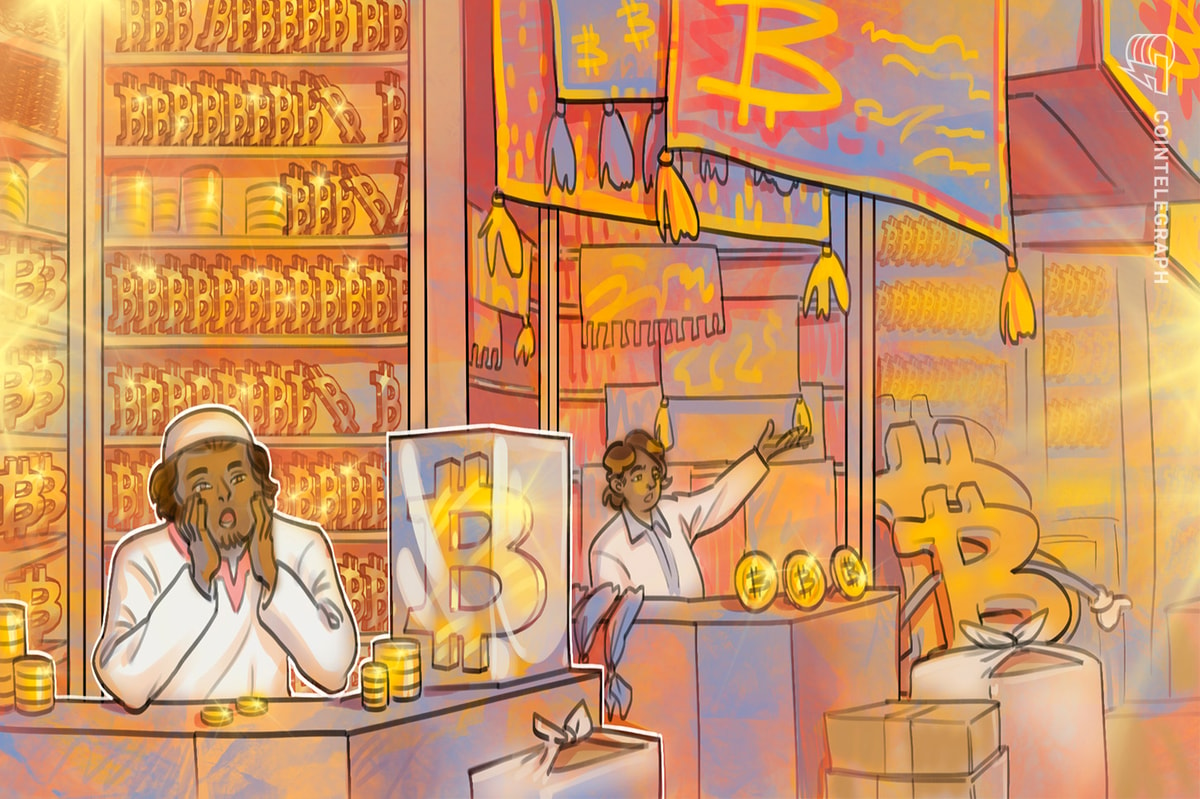Uncategorized
XRP price may drop another 40% as Trump tariffs spook risk traders
Published
6 days agoon
By
admin
The XRP (XRP) market is flashing warning signs as a bearish technical pattern emerges on its weekly chart, coinciding with macroeconomic pressures from anticipated US tariffs in April.
XRP descending triangle pattern hints at 40% drop
Since its late 2024 rally, the XRP price chart has been forming a potential triangle pattern on its weekly chart, characterized by a flat support level mixed with a downward-sloping resistance line.
A descending triangle pattern forming after a strong uptrend is seen as a bearish reversal indicator. As a rule, the setup resolves when the price breaks below the flat support level and falls by as much as the triangle’s maximum height.
XRP/USD weekly price chart. Source: TradingView
As of March 28, XRP was testing the triangle’s support for a potential breakdown move. In this case, the price may fall toward the downside target at around $1.32 by April, down 40% from current price levels.
XRP’s descending triangle target echoes veteran trader Peter Brandt’s prediction. He warned of a possible decline to as low as $1.07 due to a “textbook” head-and-shoulders pattern forming on the daily chart.
XRP/USD daily price chart. Source: Peter Brandt
Conversely, a rebound from the triangle’s support level could lead the price toward its upper trendline at around $2.55. A clear breakout above this resistance level risks invalidating the bearish structures altogether, instead sending the price toward the previous high of $3.35.
Trump tariffs could amplify XRP sell-off
The broader market, meanwhile, has turned increasingly cautious in response to President Donald Trump’s 25% tariffs on auto imports, set to go live on April 3.
These tariffs are likely to result in higher prices for US manufacturers and consumers. The February 2025 US CPI report already showed a 0.2% month-over-month increase.
Related: Is altseason dead? Bitcoin ETFs rewrite crypto investment playbook
St. Louis Federal Reserve President Alberto Musalem estimated that these tariffs might contribute approximately 1.2 percentage points to inflation, with about 0.5 percentage points stemming from direct effects and 0.7 percentage points from indirect effects.
According to the CME FedWatch Tool, the probability of the Federal Reserve cutting rates to a target range of 400–425 basis points in June has fallen to 55.7% as of March 28, down from 67.3% a week earlier and 58.4% just one day ago.
Target rate probabilities for the June Fed meeting. Source: CME
A delayed rate cut would reduce the flow of capital into speculative markets, stalling momentum for XRP and other digital assets that thrive in a low-rate, risk-on environment.
This article does not contain investment advice or recommendations. Every investment and trading move involves risk, and readers should conduct their own research when making a decision.
Kraken Secures Restricted Dealer Status in Canada Amid 'Turning Point' for Crypto in the Country Binance Sidelines Pi Network Again In Vote To List Initiative, Here’s All XRP Price Reversal Toward $3.5 In The Works With Short And Long-Term Targets Revealed Former New York governor advised OKX over $505M federal probe: Report First Digital USD (FDUSD) Depegs After Justin Sun Alleges Firm Is ‘Insolvent’ and Not Fulfilling Redemptions Gen Z’s Bitcoin Bet, The Largest Wealth Transfer In History? Published on By Cryptocurrency exchange OKX reportedly hired former New York Governor Andrew Cuomo to advise it over the federal probe that resulted in the firm pleading guilty to several violations and agreeing to pay $505 million in fines and penalties. Cuomo, a New York-registered attorney, advised OKX on legal issues stemming from the probe sometime after August 2021 when he resigned as New York overnor, Bloomberg reported on April 2, citing people familiar with the matter. “He spoke with company executives regularly and counseled them on how to respond to the criminal investigation,” Bloomberg said. The Seychelles-based firm pled guilty to operating an unlicensed money-transmitting business in violation of US Anti-Money Laundering laws on Feb. 24 and agreed to pay $84 million worth of penalties while forfeiting $421 million worth of fees earned from mostly institutional clients. The breaches occurred from 2018 to 2024 despite OKX having an official policy preventing US persons from transacting on its crypto exchange since 2017, the Department of Justice noted at the time. A spokesperson for Cuomo, Rich Azzopardi, told Bloomberg that Cuomo has been providing private legal services representing individuals and corporations on a variety of matters since resigning as New York governor. “He has not represented clients before a New York city or state agency and routinely recommends former colleagues for positions,” Azzopardi added. OKX reportedly wasn’t willing to comment on its relationships with outside firms. Cuomo, who is now running for mayor of New York City, also advised OKX to appoint his friend US Attorney Linda Lacewell to OKX’s board of directors, Bloomberg said. Lacewell, a former superintendent of the New York Department of Financial Services, was added to the board in 2024 and was named OKX’s new chief legal officer on April 1, according to a recent company statement. Source: Linda Lacewell Related: New York bill aims to protect crypto investors from memecoin rug pulls After the investigation concluded, OKX said it would seek out a compliance consultant to remedy the issues stemming from the federal probe and bolster its regulatory compliance program. “Our vision is to make OKX the gold standard of global compliance at scale across different markets and their respective regulatory bodies,” OKX CEO Star Xu said in a Feb. 24 X post. Magazine: Financial nihilism in crypto is over — It’s time to dream big again Published on By Sentient, an artificial intelligence development platform backed by Peter Thiel’s Founders Fund, has released an open-source AI search framework that it says outperforms leading closed-source competitors. The company announced the public release of Open Deep Search (ODS) on April 2, describing it as a high-performance, developer-friendly alternative to platforms like Perplexity AI and OpenAI’s GPT-4o. Sentient’s ODS aims to empower developers with open-source “Loyal AI” models, which Sentient says preserve the original intent of their developers. The firm’s fingerprinting technology allows developers to protect intellectual property while maintaining model openness — aiming to solve the biggest issue of open-source AI, the challenges of monetizing a model without centralization. “AI should belong to the community, not controlled by closed-source corporations,” according to Himanshu Tyagi, co-founder of Sentient and professor at the Indian Institute of Science. “We’re building, monetizing and delivering open-source AI with a key principle in mind: singularity in intelligence but plurality in use cases,” he added. ”Open-source development ensures performance and user control that closed systems simply cannot match.” Related: Crypto trader turns $2K PEPE into $43M, sells for $10M profit Sentient’s ODS scored 75.3% accuracy on the “Frames” benchmark, which measures factuality, retrieval and reasoning capabilities, used to answer complex “multi-hop questions” that require the integration of multiple sources. ODS surpassed OpenAI’s ChatGPT-4o Search Preview’s 50.5% and the Perplexity Sonar Reasoning Pro, which scored 44.4%. To prevent potential bias, Sentient ensured that its researchers didn’t have access to the Frames testing sets during the benchmarking process. Dobby NFT mint. Source: Sentient “Independent verification is only needed for closed-source solutions because open-source solutions have no incentive to falsely report the evaluations,” Tyagi said, adding: “Anyone with a computer can run our code, reproduce our results, and verify whether it is correct or not. The numbers reported can be reproduced using the repo’s eval section by anyone and thus are globally verifiable.” The ODS release follows growing interest in Sentient’s platform. The firm said it amassed more than 1.8 million waitlist registrations in the lead-up to the launch. Related: $1T stablecoin supply could drive next crypto rally — CoinFund’s Pakman The release of Sentient’s new open-source search framework comes amid a tipping point for open-source AI development. “We’re witnessing a significant shift as open-source AI solutions increasingly challenge closed-source dominance,” Tyagi said. “Examples such as DeepSeek’s advancements in reasoning, Manus’s innovations with agents, and now our own contributions to ODS with advanced AI search frameworks highlight this shift,” he added. “Open-source models can easily outperform closed-source giants with the right architecture,” said Sewoong Oh, Sentient’s lead researcher and professor at the University of Washington. “The results of these benchmarks validate our mission to create an open ecosystem that benefits all AI builders and users.” The launch also builds on Sentient’s earlier momentum. In February, the firm completed one of the largest NFT minting campaigns to date, with more than 650,000 participants gaining fractional ownership of its AI models. Magazine: ‘Chernobyl’ needed to wake people to AI risks, Studio Ghibli memes: AI Eye Published on By Bitcoin (BTC) investors who bought BTC in 2020 or later are still waiting for higher prices, new research says. In findings published on X on April 1, onchain analytics firm Glassnode revealed that $110,000 was not high enough to make many hodlers sell. Bitcoiners who entered the market between three and five years ago have retained their holdings despite significant BTC price upside. According to Glassnode, this investor cohort, with a cost basis between the 2020 lows of $3,600 and the 2021 highs of $69,000, is still hodling. “Although the share of wealth held by investors who bought $BTC 3–5 years ago has declined by 3 percentage points since its November 2024 peak, it remains at historically elevated levels,” it said. “This suggests that the majority of investors who entered between 2020 and 2022 are still holding.” Bitcoin Realized Cap HODL Waves data. Source: Glassnode An accompanying chart shows data from the Realized Cap HODL Waves metric, which splits the BTC supply into sections based on when each coin last moved onchain. Using this, Glassnode is able to draw a distinction between the 2020-22 buyers and those who came immediately before them. “In contrast, over two-thirds of those who had bought $BTC 5–7 years ago exited their positions by the December 2024 peak,” it reveals, reflecting their lower cost basis. As Cointelegraph reported, more recent buyers, who form the more speculative investor cohort known as short-term holders (STHs), have proven much more sensitive to recent BTC price volatility. Related: Bitcoin sellers ‘dry up’ as weekly exchange inflows near 2-year low Episodes of panic selling have occurred throughout the past six months as BTC/USD hit new record highs and then fell by up to 30%. Continuing, Glassnode said that current STH participation does not suggest a speculative frenzy — something common to previous BTC price cycle tops. “Short-Term Holders currently hold around 40% of Bitcoin’s network wealth, after peaking near 50% earlier in 2025,” it said, alongside Realized Cap HODL Waves data on March 31. “This remains significantly below prior cycle tops, where new investor wealth peaked at 70–90%, suggesting a more tempered and distributed bull market so far.” Bitcoin Realized Cap HODL Waves. Source: Glassnode This article does not contain investment advice or recommendations. Every investment and trading move involves risk, and readers should conduct their own research when making a decision. Arthur Hayes, Murad’s Prediction For Meme Coins, AI & DeFi Coins For 2025 Expert Sees Bitcoin Dipping To $50K While Bullish Signs Persist Aptos Leverages Chainlink To Enhance Scalability and Data Access Bitcoin Could Rally to $80,000 on the Eve of US Elections Sonic Now ‘Golden Standard’ of Layer-2s After Scaling Transactions to 16,000+ per Second, Says Andre Cronje Crypto’s Big Trump Gamble Is Risky Institutional Investors Go All In on Crypto as 57% Plan to Boost Allocations as Bull Run Heats Up, Sygnum Survey Reveals Ripple-SEC Case Ends, But These 3 Rivals Could Jump 500x
Source link You may like












Uncategorized
Former New York governor advised OKX over $505M federal probe: Report

Cuomo also influenced OKX to make executive appointments: Bloomberg
Source link Uncategorized
Sentient open-source AI search outperforms GPT-4o and Perplexity

Sentient’s ODS outperforms ChatGPT, Perplexity
A turning point for open-source AI
Source link Uncategorized
Bitcoin sales at $109K all-time high ‘significantly below’ cycle tops — Research

Glassnode: 2020 Bitcoin buyers “still holding”
Speculators stay cool at BTC price highs
Source link 
Kraken Secures Restricted Dealer Status in Canada Amid 'Turning Point' for Crypto in the Country

Binance Sidelines Pi Network Again In Vote To List Initiative, Here’s All

XRP Price Reversal Toward $3.5 In The Works With Short And Long-Term Targets Revealed

Former New York governor advised OKX over $505M federal probe: Report

First Digital USD (FDUSD) Depegs After Justin Sun Alleges Firm Is ‘Insolvent’ and Not Fulfilling Redemptions

Gen Z’s Bitcoin Bet, The Largest Wealth Transfer In History?

Trump’s Crypto Conflicts Dominate Stablecoin Legislation Debate

First Digital denies allegations, threatens legal action

Crypto Firm Galaxy Secures UK FCA Approval for License to Expand Derivatives Trading

Why Is The Bitcoin Price Surging Today?

Cardano Founder Reveals What Will Onboard 3 Billion New Users Into Crypto

Sentient open-source AI search outperforms GPT-4o and Perplexity

Memecoin Collapse Creates Perfect Moment for TradFi To Launch ‘Trusted Assets,’ According to Chris Burniske

Breez Announces Launch Of New Wallet, Misty Breez

Alabama, Minnesota Advance Bitcoin Reserve Plans With Companion Bills

Arthur Hayes, Murad’s Prediction For Meme Coins, AI & DeFi Coins For 2025

Expert Sees Bitcoin Dipping To $50K While Bullish Signs Persist

Aptos Leverages Chainlink To Enhance Scalability and Data Access

Bitcoin Could Rally to $80,000 on the Eve of US Elections

Sonic Now ‘Golden Standard’ of Layer-2s After Scaling Transactions to 16,000+ per Second, Says Andre Cronje

Crypto’s Big Trump Gamble Is Risky

Institutional Investors Go All In on Crypto as 57% Plan to Boost Allocations as Bull Run Heats Up, Sygnum Survey Reveals

Ripple-SEC Case Ends, But These 3 Rivals Could Jump 500x

Has The Bitcoin Price Already Peaked?

A16z-backed Espresso announces mainnet launch of core product

Xmas Altcoin Rally Insights by BNM Agent I

Blockchain groups challenge new broker reporting rule

The Future of Bitcoin: Scaling, Institutional Adoption, and Strategic Reserves with Rich Rines

Trump’s Coin Is About As Revolutionary As OneCoin

Is $200,000 a Realistic Bitcoin Price Target for This Cycle?
Trending


















